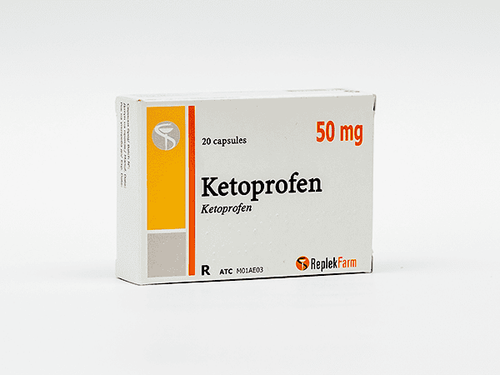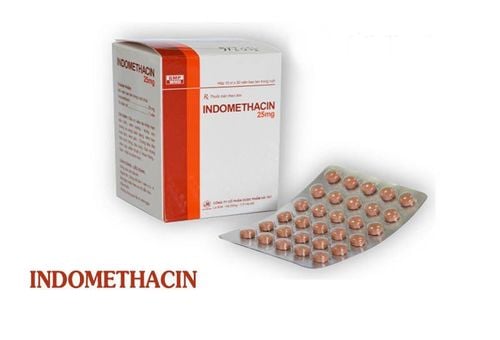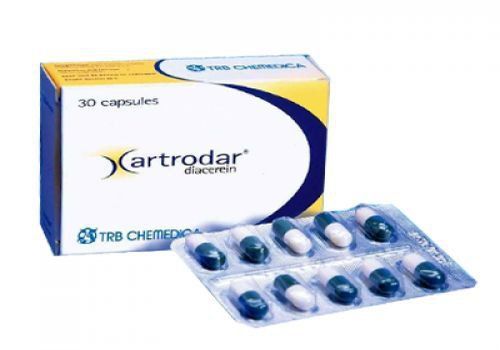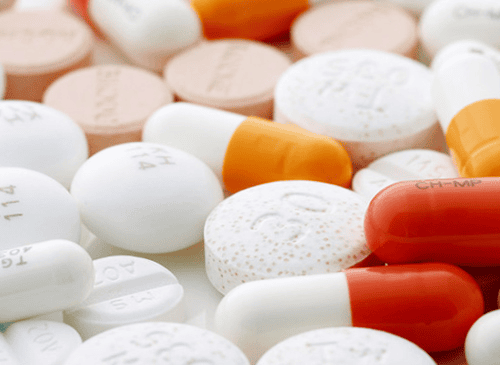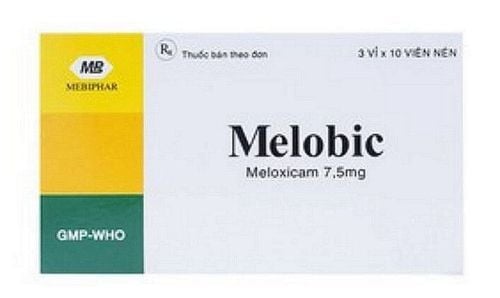This is an automatically translated article.
Kamelox 15mg is a non-steroidal anti-inflammatory and pain reliever drug, so Kamelox 15mg is indicated for symptomatic treatment of chronic pain in a number of osteoarthritis diseases such as osteoarthritis, rheumatoid arthritis, spondylitis, and spondylitis. joint,...1. What is Kamelox 15?
The product Kamelox 15 has the main ingredient Meloxicam 15mg. Meloxicam is a derivative of oxicam and belongs to the group of non-steroidal anti-inflammatory drugs. Kamelox's anti-inflammatory mechanism is to inhibit the biosynthesis of prostaglandins, a mediator of inflammation, pain, and fever. More specifically, the effect of the active ingredient Meloxicam in Kamelox is to inhibit the enzyme cyclooxygenase (referred to as COX), thereby reducing the synthesis of prostaglandins.It should be noted that Meloxicam inhibits COX-2 enzyme only about 10 times more than COX-1, so Kamelox 15 is classified as an NSAID that inhibits COX-2, not a selective COX-2 inhibitor. . The degree of COX-1 inhibition of Meloxicam depends on the dose used and the location of each patient. At a dose of 7.5 mg/day (equivalent to 1/2 of a Kamelox 15 tablet) the COX-1 inhibition was less than that of 15 mg/day (1 Kamelox 15 tablet). Because of its ability to inhibit COX-1 (though not much) on platelets, it is possible to reduce the synthesis of thromboxane A2, thereby providing an antiplatelet effect. Another advantage of Kamelox is that despite inhibiting COX-1, it causes less adverse effects on the gastrointestinal mucosa when compared with non-selective COX inhibitors.
Pharmacokinetic characteristics of the drug Kamelox 15mg:
Absorption: Meloxicam administered orally has a bioavailability of about 89%. The drug concentration in the blood plasma is proportional to the dose, after taking Meloxicam 7.5mg and 15mg, the average plasma concentration is 0.4 - 1 mg/l and 0.8 - 2 mg/l, respectively; Distribution: The active ingredient Meloxicam in Kamelox is strongly bound to plasma proteins, mainly albumin (about 99%). Kamelox has good ability to diffuse into synovial fluid with concentrations equivalent to 50% of plasma concentrations, however, the free form of Meloxicam in synovial fluid is 2.5 times higher than in plasma because synovial fluid has less protein; Metabolism: Kamelox is almost completely metabolised in the liver, especially by oxidation of the methyl radical of the thiazolyl nucleus through the catalysis of CYP2C9 and a small amount of CYP3A4; Elimination: Meloxicam is not metabolized and is excreted in approximately 3% of the dose. Meloxicam is excreted in the urine and in the feces in equal proportions. The half-life is about 20 hours with a mean plasma clearance of about 8 ml/min and decreases with age.
2. Indications and contraindications of the drug Kamelox 15mg
The drug Kamelox is used for the purpose of symptomatic treatment in the following diseases:Osteoarthritis pain such as joint damage, osteoarthritis; Rheumatoid arthritis ; Ankylosing spondylitis. Besides, Kamelox is contraindicated for use in the following cases:
People who are sensitive to Meloxicam, allergic to aspirin or other non-steroidal anti-inflammatory drugs; People with bronchial asthma, nasal polyps, angioedema or Quincke's edema, urticaria after taking Aspirin or other NSAIDs; Patients with advanced gastric or duodenal ulcer, gastric or cerebral hemorrhage; Severe liver or kidney failure; Children under 18; Pregnant women or nursing mothers should not take Kamelox 15mg.
3. Instructions for using Kamelox 15mg
Kamelox 15 products are for oral use only with specific dosages as follows:Rheumatoid arthritis, ankylosing spondylitis: The recommended dose is 15mg of Meloxicam once a day, equivalent to 1 Kamelox 15 tablet. ; Persons at high risk for adverse reactions from Meloxicam should start at a dose of 7.5 mg once daily, equivalent to 1/2 of a Kamelox 15 tablet; Elderly people who need long-term treatment with Meloxicam should use a dose of 7.5mg / time / day, equivalent to 1/2 Kamelox 15 tablet; In case of severe osteoarthritis pain should be started at 7.5mg/day, then can be increased to 15mg/day and used only once a day; Patients with end-stage renal failure on hemodialysis can take 7.5mg of Meloxicam per day, equivalent to 1/2 of a Kamelox 15 tablet.
4. Some cautions when taking Kamelox 15mg
Cases with a history of peptic ulcer or taking anticoagulants should be cautious when using Kamelox because of the risk of peptic ulcer, even gastrointestinal bleeding. At the same time, during the use of Kamelox, if there are abnormal manifestations on the skin, on the mucous membranes or signs of ulceration or gastrointestinal bleeding, it is necessary to stop the drug Kamelox 15mg immediately. The active ingredient Meloxicam in Kamelox products inhibits the biosynthesis of prostaglandins in the kidneys, thus easily leading to dehydration, cirrhosis of the liver, congestive heart failure or kidney diseases. This necessitates the use of Kamelox with caution and close monitoring in patients with impaired renal function.Kamelox 15 mg medicine can cause dizziness and drowsiness as a side effect, so it is not recommended to use when driving or operating complex machinery.
Meloxicam in the drug Kamelox is highly toxic and causes many undesirable effects on the digestive system, hematology, skin, respiratory and central nervous system, so the drug Kamelox is not indicated for use in women. Pregnant. This also applies to the group of mothers who are breastfeeding.
5. Undesirable effects of Kamelox 15
Common side effects of Kamelox (ADR >1/100):Gastrointestinal disturbances such as nausea, vomiting, abdominal pain, constipation or diarrhea, abdominal distension; Causes anemia; Itching, skin rash; Headache; Edema. Some rare side effects when using Kamelox 15 (1/1000 < ADR < 1/100):
Slight increase in liver enzymes and bilirubin; Ợ gas, esophagitis, peptic ulcer; Potential gastrointestinal bleeding; Decrease in white blood cells, platelets; Stomatitis; Urticaria; Hypertension, palpitations, flushing; Increased levels of creatinine and blood urea; Dizziness, tinnitus and drowsiness. In addition, users of Kamelox 15 may experience some rare side effects (ADR < 1/1000) as follows:
Colitis ; Perforation of gastric - duodenal ulcer; Hepatitis; Skin increased sensitivity to light; Erythema multiforme, Steven-Johnson syndrome, Lyell syndrome; Acute bronchial asthma attacks; Angioedema of the nervous system; Defensive shock. Instructions to manage ADR of Kamelox 15:
To limit the undesirable effects of Meloxicam on the gastrointestinal tract, patients need to take the drug immediately after a meal or it can be combined with antacids and/or protection. gastric mucosa; With mild adverse reactions, patients may improve by discontinuing Kamelox. In case of serious side effects or allergic reactions, the user should receive appropriate supportive intervention.
6. Drug interactions of Kamelox 15 . products
Some products should not be combined with Kamelox 15mg because of dangerous drug interactions:Do not combine Kamelox with products containing other non-steroidal anti-inflammatory agents (including high-dose Salicylate) because it may increase the risk. peptic ulcer and gastrointestinal bleeding due to a synergistic effect; Do not combine Kamelox with oral anticoagulants, Ticlopidine, Heparin and thrombolytic drugs due to the increased risk of bleeding; Lithium: The meloxicam in Kamelox can increase blood levels of Lithium, so the combination should not be used. In case of mandatory use of both, it is necessary to closely monitor the blood lithium concentration; Methotrexate: Similar to other non-steroidal anti-inflammatory drugs, the active ingredient Meloxicam in Kamelox increases the hematological toxicity of Methotrexate. When combined, it is necessary to closely monitor the blood count; Intrauterine IUDs: Non-steroidal anti-inflammatory drugs such as Kamelox can reduce the effectiveness of birth control. Some products need caution when combined with Kamelox:
Diuretics: Combining non-steroidal anti-inflammatory drugs with diuretics increases the possibility of acute renal failure in dehydrated patients. Therefore, if combined, it is necessary to pay attention to fully rehydrate the patient and monitor renal function before and during treatment; Antihypertensives (including alpha-adrenergic blockers, ACE inhibitors, vasodilators, diuretics): Use of nonsteroidal anti-inflammatory drugs such as Kamelox may reduce the antihypertensive effect due to total inhibition. combination of prostaglandins that cause vasodilation; Cholestyramine can bind to Meloxicam in the gastrointestinal tract and lead to decreased absorption and increased elimination of Meloxicam; Ciclosporin: Kamelox is similar to NSAIDs in that both can increase the nephrotoxicity of Cyclosporin, if combined, it is necessary to monitor renal function closely; Warfarin: Kamelox may increase the likelihood of bleeding, so bleeding time should be monitored when taken together.
Please dial HOTLINE for more information or register for an appointment HERE. Download MyVinmec app to make appointments faster and to manage your bookings easily.




